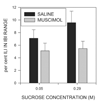Inactivation of the median raphe nucleus increases intake of sucrose solutions: a microstructural analysis
- PMID: 21688889
- PMCID: PMC3144310
- DOI: 10.1037/a0024372
Inactivation of the median raphe nucleus increases intake of sucrose solutions: a microstructural analysis
Abstract
Previous studies have shown that microinjections of the GABA-A agonist muscimol into the median raphe nucleus (MR) result in large increases in the intake of solid foods. In the current study, we used microstructural techniques to characterize the effects of intra-MR muscimol injections on the consumption of either a 0.05 M or a 0.29 M sucrose solution. After injections of either saline or muscimol, animals consumed more of the 0.29 M than the 0.05 M solution, an effect which resulted primarily from increases in the initial rate of consumption with no change in the rate at which licking decayed across the test session. In contrast, intra-MR muscimol injections had little effect on the initial licking rate, but greatly increased meal duration, indicating that this treatment affected ingestion in a different way than did altering the sucrose concentration. Muscimol injections produced a significantly larger increase in the intake of the 0.29 M than of the 0.05 M solution. Intra-MR muscimol injections did not alter the within burst rate of licking, suggesting that they did not affect the functioning of the licking pattern generator. In contrast, these injections did increase the number of licks contained within "clusters," that is groups of licks separated from each other by intervals of more than 0.5 sec. These findings show that inactivation of the MR produces a powerful effect on the intake of liquid diets, and that the nature of this effect is different from that produced here by changes in sucrose concentration and from those reported after pharmacological manipulations of a number of other brain systems. We additionally discuss several theoretical issues arising in the interpretation of microstructural data. (PsycINFO Database Record (c) 2011 APA, all rights reserved).
Figures






References
-
- Asin KE, Davis JD, Bednarz L. Differential effects of serotonergic and catecholaminergic drugs on ingestive behavior. Psychopharmacology. 1992;109:415–421. - PubMed
-
- Asin KE, Wirtshafter D, Kent EW. Straight alley acquisition and extinction and open field activity following discrete electrolytic lesions of the mesencephalic raphe nuclei. Behavioral and Neural Biology. 1979;25:242–256. - PubMed
-
- Baird JP, Gray NEE, Fischer SG. Effects of neuropeptide Y on feeding microstructure: Dissociation of appetitive and consummatory actions. Behavioral Neuroscience. 2006a;120:937–951. - PubMed
-
- Baird JP, Rios C, Gray NE, Walsh CE, Fischer SG, Pecora AL. Effect of melanin-concentrating hormone on licking microstructure and brief-acess taste responses. American Journal of Physiology, Regulatory, Integrative and Comparative Physiology. 2006b;294 R12656-R1274. - PubMed

